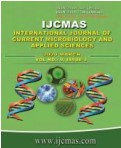


 National Academy of Agricultural Sciences (NAAS)
National Academy of Agricultural Sciences (NAAS)

|
PRINT ISSN : 2319-7692
Online ISSN : 2319-7706 Issues : 12 per year Publisher : Excellent Publishers Email : editorijcmas@gmail.com / submit@ijcmas.com Editor-in-chief: Dr.M.Prakash Index Copernicus ICV 2018: 95.39 NAAS RATING 2020: 5.38 |
Laboratory studies were conducted to study the effect of six botanicals (neem leaf extract, garlic bulb extract, eucalyptus leaf extract, castor oil, mustard oil, neem oil) and two bio products (vermin wash, cow urine) were evaluated against against A. cucumerina var. cyamopsidis under in-vitro condition. Maximum mycelium inhibition was recorded in Garlic bulb extract followed by Neem leaf extract and Cow urine. Nine fungicides [Difenconazole (25EC), Chlorothalonil (75WP), Carbendazim 12% + Mancozeb 63%WP, Mancozeb (75), kitazin (48%EC), Hexaconazole 50%, Tebuconazole 50% + Trifloxystrobin 25%, Azoxystrobin, Tricyclazole] evaluated against Alternaria cucumerina var. cyamopsidis under in-vitro condition. All the fungicide inhibited the mycelial growth at all concentrations of fungicides. Difenconazole (100%), Tebuconazole 50% + Trifloxystrobin 25% (100%) and Azoxystrobin (100%), completely inhibited the growth at 500ppm concentration. A field experiment conducted to know the efficacy of four botanicals (Neem leaf extract, Garlic bulb extract, Neem oil, Cow urine) and six fungicides (Carbendazim 12% + Mancozeb 63%WP, Difenconazole (25EC), Tebuconazole 50% + Trifloxystrobin 25%, Chlorothalonil (75WP), Azoxystrobin) against Alternaria blight in foiler disease. Among the treatments, minimum disease incidence was recorded in Difenconazole (25EC), followed by Carbendazim 12% + Mancozeb 63%WP, Chlorothalonil (75WP) and Azoxystrobin. Among the botanicals, minimum disease incidence was recorded in Garlic bulb extract.
 |
 |
 |
 |
 |